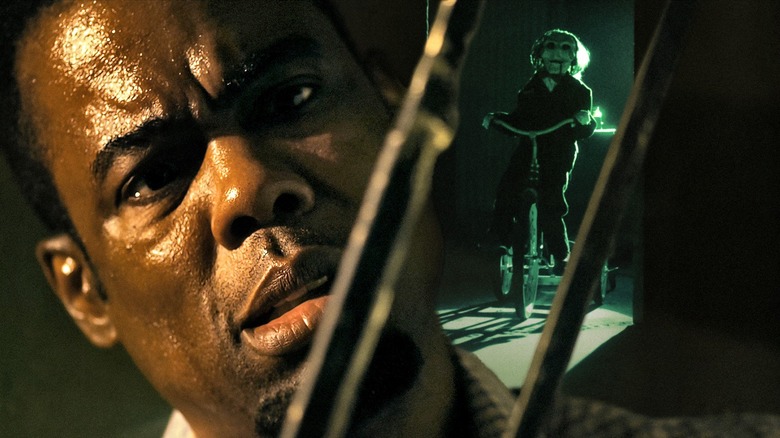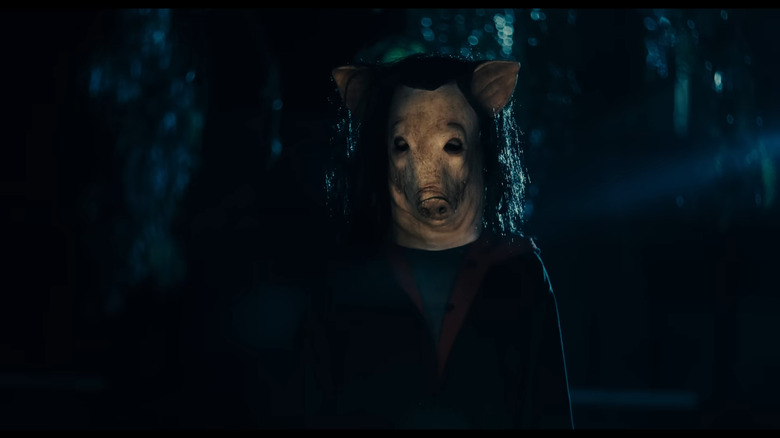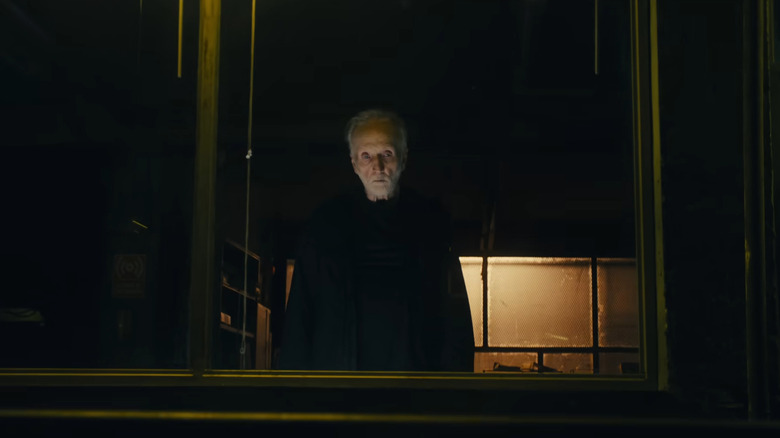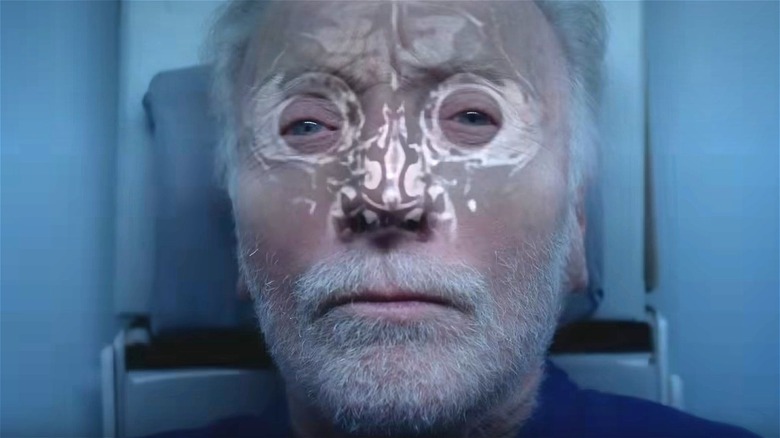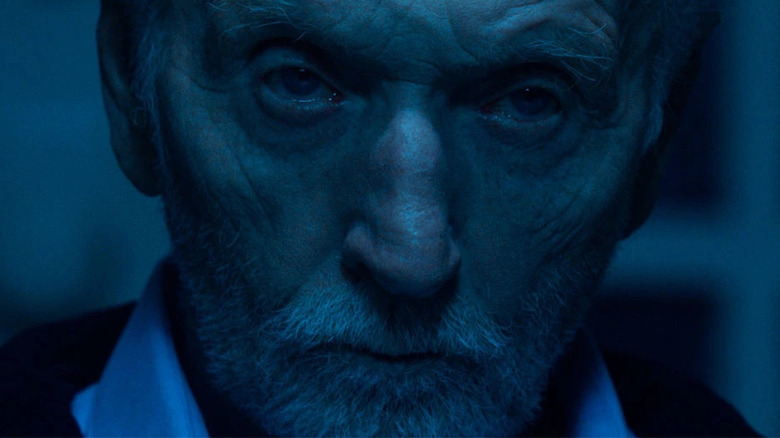Saw X Hacks Off Spiral's Best Achievement (& Locks Itself Back Into A Continuity Trap)
There's no question that the original "Saw" film is one of the most influential horror movies of the 21st century, spawning a craze of creatively ultra-violent stories, as well as six direct sequels that all maintained one deliciously complicated storyline. But with "Saw X" flaunting its return to this convoluted continuity, the franchise has wasted the promise of "Spiral."
Though no "Saw" film has ever been met with widespread critical acclaim (they're essentially cult classics with a great idea of who their target audience is and what they want, critics be damned), the two films released after "Saw: The Final Chapter" were met with two of the most positive receptions thus far — arguably because they showed what the franchise could do when freed from the constraints of the previous seven-movie saga. First, the very rewatchable "Jigsaw" ditched the abrasive (yet admittedly distinct) visual aesthetics for a sleeker presentation, proving that a "Saw" film could look sexy without sacrificing gore or terror. The Chris Rock-starring "Spiral," though, was the true gamechanger — because it explicitly threw aside the past to build something genuinely new.
"Spiral" broke ground by introducing tones, characters, and actors you wouldn't normally associate with the franchise, and perhaps most importantly, didn't shoehorn in a role for the long-deceased John Kramer (Tobin Bell), instead crafting a story that could be enjoyed independently of its predecessors. Between the fresh visuals, writing style, characters, and even its title, "Spiral" proposed a future for "Saw" that was built on freer standalone installments, where creatives could take the franchise's basic elements (traps, gore, and mystery) and present them in a new light, instead of using each movie to further complicate an already ludicrously convoluted continuity.
Instead of giving us the "Spiral 2" we should've had, "Saw X" is sprinting backwards.
The overarching storyline of the Saw series is a gift and a curse
Let's be clear: convoluted as the first seven "Saw" movies may be, there's a certain brilliance to the narrative.
While lesser horror franchises put out reboots or "requels" every few years, "Saw" has always held its continuity in a tight fist. Throughout the movies, there is a painstaking adherence to worldbuilding that genuinely rewards the most devout disciples of Jigsaw. Characters like Jill Tuck (Betsy Russell), Detective Mark Hoffman (Costas Mandylor), and arguably even Jigsaw himself have incredibly small roles in their first films, only to become major series protagonists as their storylines progress. Tiny details like a trail of blood leading out of the original "Saw" room ultimately pay off in reveals that alter the status quo of the universe. And even though we never actually learn where the events of the "Saw" franchise takes place, the universe feels lived-in and real.
However, with this interconnected narrative constantly progressing in leaps and bounds, the overarching story is increasingly alienating to new fans — who would perhaps already be hesitant about entering the series due to its infamous violence. By the time of "The Final Chapter," the series had become a deadly trap itself, limiting the potential of what should have been an endlessly malleable premise.
"Spiral" broke free of this. "Saw X," meanwhile, is returning to the same well, trapping the franchise at a critical point in its growth.
The Saw franchise's potential could bleed out with Saw X
A full "Saw" reboot would be rejected by most fans, who would see it as an affront to the world they are so deeply invested in. That's what made "Spiral" so clever: it cut through the excessive continuity, without jettisoning anything, to tell a new story without the baggage.
"Spiral" almost treated "Saw" as a shared universe rather than a strict series. This is exactly the approach future "Saw" movies should be taking, if the series wants to survive. This isn't to say Hollywood needs to immediately green-light "Mark Hoffman: Rebirth," but rather, that each new "Saw" movie should be a chance for filmmakers to take the same basic tools and experiment in standalone sequels.
In addition to giving "Saw" a chance to become more artistically surprising, this would allow new fans to join in, while also not ostracizing old devotees. In contrast, merely the title of "Saw X" already discourages newcomers, unless they want to watch 18 hours of homework.
Saw fans don't need more Jigsaw origin stories
As marketing makes clear, "Saw X" seeks to offer two treats to its longtime fans: the return of John Kramer and Amanda Young (Shawnee Smith), and a further exploration of Jigsaw's origin. On both counts, the film is setting itself up for failure.
The idea of a prequel in a series as relentlessly laden with flashbacks as "Saw" is already stupefyingly misguided. Even more bizarrely, this prequel is centered on John Kramer — a character whose backstory is already so fleshed-out and full of complicated additions and retcons that there's basically nothing novel left to explore. The chronological setting of "Saw X" — placed between the first two films, because everything before the first film is already covered — is a naked excuse to bring back Tobin Bell for cheap marketing nostalgia.
During development, someone in the room should've realized they were writing themselves into an unnecessary trap. So perhaps they thought bringing back Amanda, as well, would sell the prequel concept as a worthwhile endeavor — it's just too bad they spoiled her return in the trailers, again, for cheap marketing nostalgia.
Even if they hadn't, no new Amanda Young reveal could top the character twists in "Saw II" and "Saw III." At this point, learning the exact minutiae of her early relationship with John can only be about as satisfying as learning where Han got the name "Solo" from. With that in mind, there is one potential silver lining to the focus "Saw X" puts on Kramer — maybe, after this, the series can finally move on from him.
Saw X needs to be a John Kramer's swan song, and we need to get back to Spiral movies
A common complaint with the first seven "Saw" films is that the titular villain dies exactly halfway through the series, allowing its best character to only appear via flashbacks for the remainder of the saga. Sure, his influence continues, via traps, disciples, and tapes — but it nonetheless creates a sense that the series is living on borrowed time.
One of the few things "Saw X" has going for it is that it gives Jigsaw a chance to play an active role in a "Saw" film for the first time since 2006's "Saw III." For this to work most effectively, though, it also needs to be the last time.
Because of his premature death, it almost feels as though the franchise has been trying to say goodbye to John Kramer for almost two decades. If "Saw X" uses its backward-facing narrative to interrogate and explore everything that makes Jigsaw who he is, coming to a conclusion that satisfyingly resolves one of the most enigmatic horror villains in history, this film could be the franchise's most impactful. Should this come to pass, we'll happily devour every word we've written here so far. Otherwise, "Saw X" might be the last bloody supper this series enjoys.
